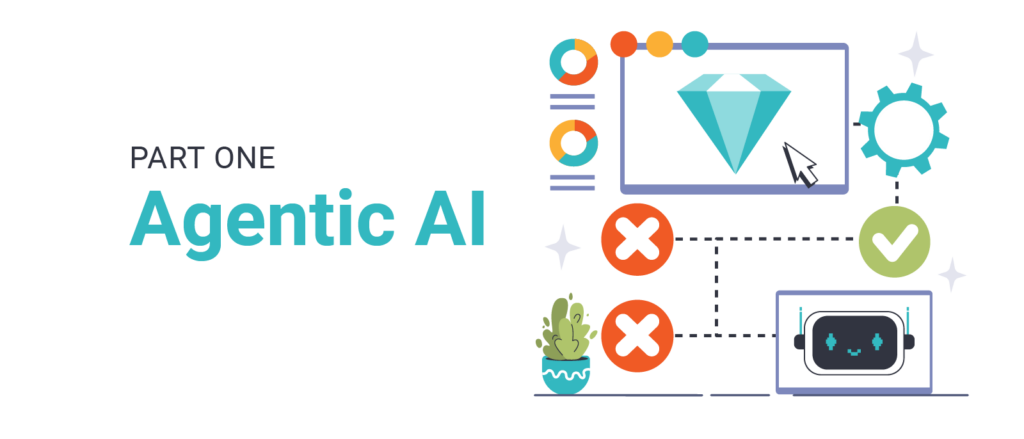What is the difference between Agentic and Generative LLM AI?
Artificial intelligence (AI) comes in various forms, each designed to address different problems and tasks. From simple rule-based systems that follow predefined instructions to advanced machine learning models that analyze data and make predictions, AI has evolved significantly over the years. However, not all AI is created equal. One of the most sophisticated types of AI is known as agentic AI.
Unlike other forms of AI that require constant human oversight or only respond to specific inputs, agentic AI is designed to act autonomously, making decisions and taking actions on its own to achieve predefined goals. This ability to operate independently and adapt to changing conditions sets agentic AI apart, making it a powerful tool in dynamic and complex environments.
Leaders in revenue cycle management (RCM) should be informed about agentic AI because it represents a significant advancement in how healthcare organizations can optimize their financial processes, reduce costs, and improve overall efficiency.
As a first step in understanding agentic AI, we’ll compare it to how a large language model operates.
Agentic AI and Large Language Models (LLMs) are both forms of artificial intelligence, but they serve different purposes and operate in distinct ways. Here’s a breakdown of the key differences:
1. Core Functionality
Agentic AI: Agentic AI is designed to operate autonomously to achieve specific goals. It can make decisions, take actions, and learn from its environment without requiring constant human oversight. Agentic AI systems are typically goal-directed, meaning they are programmed or trained to perform tasks and optimize outcomes based on predefined objectives.
Large Language Models (LLMs): LLMs, like GPT-4, are AI models trained on vast amounts of text data to understand and generate human language. Their primary function is to process and produce text based on patterns learned from their training data. They excel at natural language understanding and generation, enabling them to perform tasks like writing, summarizing, translating, and answering questions.
2. Autonomy and Decision-Making
Agentic AI: Agentic AI is characterized by its autonomy. It can make complex decisions and act on them without human intervention. It’s often embedded in systems where independent decision-making is crucial.
LLMs: While LLMs can generate responses and interact in a seemingly intelligent way, they are not autonomous in the same sense as agentic AI. LLMs typically respond to specific prompts or inputs from users. They do not take independent actions or make decisions beyond generating text based on the given input.
3. Purpose and Application
Agentic AI: The primary purpose of agentic AI is to perform tasks that require autonomy, such as navigating environments, optimizing processes, or managing systems without human oversight. It’s used in applications where ongoing decision-making and adaptation to changing conditions are essential.
LLMs: The primary purpose of LLMs is to process and generate human-like text. They are used in applications that involve communication, content creation, customer service, language translation, and more. LLMs are generally reactive, meaning they generate outputs in response to specific inputs rather than proactively acting toward a goal.
4. Learning and Adaptation
Agentic AI: Agentic AI often includes mechanisms for learning and adaptation, such as reinforcement learning, where it improves its decision-making over time based on the outcomes of its actions. It continuously adjusts its behavior to better achieve its goals.
LLMs: LLMs are pre-trained on large datasets and can fine-tune their responses based on additional training or contextual prompts. However, they don’t learn or adapt in real-time based on the outcomes of their interactions. Any “learning” requires retraining or fine-tuning on new data.
5. Interactivity
Agentic AI: Agentic AI may interact with humans or other systems, but it does so as part of its goal-directed behavior. Interaction is a means to an end, such as gathering information or negotiating actions.
LLMs: LLMs are fundamentally interactive in nature, designed to engage in conversation, answer questions, and provide information based on user input. Their interaction is the primary function, rather than a step toward achieving an independent goal.
6. Complexity and Scope
Agentic AI: Agentic AI often operates within a specific domain or set of tasks, with clear goals and the autonomy to achieve them. It’s typically more complex in terms of decision-making and action-taking capabilities.
LLMs: LLMs are general-purpose text generation tools. They are highly versatile in generating language across various topics but do not engage in complex decision-making or autonomous action.
Conclusion
Agentic AI is about autonomy, decision-making, and goal-directed behavior in a specific context, often involving real-time learning and adaptation.
LLMs are about processing and generating human-like text based on input, excelling at understanding and producing language but without autonomy or goal-directed behavior.
In essence, while both are powerful AI technologies, agentic AI is focused on autonomous action toward specific goals, whereas LLMs are focused on language processing and generation in response to user inputs.


